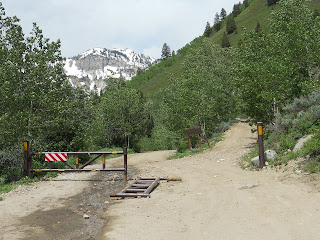Just returned from the Western Wyoming Plein Air Competition and show in Cokeville, Wyoming. It's a small competition held in conjunction with the Minerva Teichert Invitational Art Show. This was my second year in the plein air competition.
Cokeville is located in the beautiful Bear River Valley, surrounded by hills and mountains. Scattered throughout the valley and lining the edges of hayfields are old cottonwood trees. Originally my plan was to camp up in the mountains and paint there, but from the day I arrived, I got on a cottonwood kick. Here is the first one I painted, Tuesday afternoon:
 |
| Old Ranch Cottonwood, 12" x 9" Oil on Canvas Panel |
While painting this, a fast moving storm chased me into a nearby cabin. After the storm passed, I dragged my painting gear back out to the same spot and began painting again. As I finished the painting, a horse came by to visit me. The horse brought with it lots of flies, many of which promptly stuck themselves to my painting. Somehow, the flies continued to stick themselves to the painting even after the horse left. I had to do a lot of fly removal and painting over spots to complete this piece.
Wednesday morning's sky was cloudless, but a waning gibbous moon hung over the western sky just in the right spot to become part of the next painting:
 | |||||
| Morning Moon Over Cottonwoods. 11" x 14" Oil on Canvas Panel |
The second painting I tried that day didn't work out, so I wiped it. Later that evening, I did a little landscape painting down the road from the Dayton ranch with the shows organizer, Charles Dayton. Thursday, I walked out into a hayfield, set up and painted this:
 |
| Red Roof and Cottonwoods, 9" x 12" Oil on Canvas Panel |
I just love the gestures, postures and attitudes of the Bear River Valley cottonwoods. Working outdoors has it's benefits for wildlife watchers. There were a few pairs of red-tail hawks in the general area. When one red-tail would wander into the territory of another, a running skirmish on the wing would occur until the trespassing red-tail was chased from the airspace of the resident hawks. There were also sandhill crane and glossy ibis. While I was painting near a large flock of ibis, a red-tail hawk swooped low over the ibis, spooking them and causing the entire flock to take flight. Occasionally, a nearby marmot would chirp it's protest at my proximity to it's burrow. Over on the other side of town, I got out the panel I had wiped the day before and painted this:
 |
| Legion Park Lane, 11" x 14" Oil on Canvas Panel |
Friday morning was my last chance to paint for the competition. Paintings had to be framed and ready to hang by late afternoon. Near Pine Creek Canyon I found my last subject to paint:
 |
| Pine Creek Canal, 9" x 12" Oil on Canvas Panel |
Saturday morning, I headed off to explore the Bridger - Teton National Forest for future painting opportunities. At one point a weasel ran out in front of my car. It stopped and turned to look at me as I braked to avoid running over the little predator, then it darted the rest of the way across the dirt road. Driven by the curse of wondering what was around the next bend I drove farther than I should have and had to drive through part of Idaho to get back to Cokeville. Arriving twenty minutes late for Saturday's opening of the show, I was surprised to learn two of my paintings had already sold! Later that day I was awarded the peoples choice award in the plein air category.
This had been a good trip. The weather had been great, and the painting had gone well. Plus I returned with more income than expenses! But by the end of the week, I was worn out.


































